Karachi hosts the world’s greatest—and most ostentatious—version of the Abrahamic slaughter ritual, fueling a turf war between criminals and strongmen of political and religious parties.
“You don’t have to eat this if you don’t want to,” my mother whispered, as we stared mournfully at our plates of pinkish, strange-smelling meat. I was six or seven years old, but I’d never seen anything like this before—beef. My mother, who swore off meat after her second pregnancy, could barely touch it herself.
We tried to hide our grimaces. It was Eid. My parents, as expatriate Pakistanis in the United Arab Emirates, were attempting to recreate the holiday by dining with the few relatives and friends who lived in different parts of the country. On this Eid, we had driven from our home in Sharjah to Ras al-Khaimah, in the north, to have lunch with my parents’ friends.
There was a victorious air to the proceedings. This feast was a rare event during my secure, sanitized existence in the UAE, where food was neatly packaged and sold in brightly-lit supermarkets. I was encountering freshly sacrificed meat for the first time. My parent’s friends had excitedly brought it that day from the abattoir, and it was now being served up as Eid lunch. The apartment was full of people dining on the spoils of the butcher, somehow able to ignore the pungent odor.
We left early.
When I moved to Pakistan in 1994, I encountered the full force of Eid for the first time, for Karachi’s version was one like no other. While our flat remained free of blood and bones, the parking lot of our apartment building would fill with cows and goats and their minders. I would stand on the balcony of my grandmother’s Karachi home and watch the goats being slaughtered. I was horrified. In the years that followed, I spent every Eid sleeping in so I wouldn’t have to hear the sounds of animals bleating as they faced their bloody end.

As I grew older, however, I could no longer pull the covers over my head and pretend the ritual slaughter didn’t exist. Karachi is a pushy beast—even if you sidestep the goats, their smell gets stuck in your nostrils, their droppings glued to the soles of your shoes. Sacrificial meat will arrive in a bloody bag, sent over by a neighbor. Strangers will come around asking for contributions to some unheard-of charity. It’s hard to ignore the animals. They’re everywhere.
Eid is one of the two major celebrations in the Islamic calendar, and it is tied to the Hajj, the annual pilgrimage to Mecca made by millions of Muslims. While Eid-ul-Fitr marks the end of a month of fasting, Eid-al-Adha is rooted in Abrahamic tradition. God commanded Abraham to sacrifice his son, and as he prepared to kill him, Abraham found that God had mercifully replaced the son with a dead ram. Muslims commemorate that spirit of sacrifice and obedience to God with a three-day remembrance that involves slaughtering animals—usually cows, goats, sheep, and camels—and dividing the meat among friends, family, and the poor.
Eid is a time where legends are born and criminals thrive
In many ways, the soul of Karachi is written out in the city’s version of Eid-al-Adha, when the streets run with blood as thousands of animals are felled in the name of sacrifice. Eid in Karachi is the country’s greatest—or at least its most ostentatious—Abrahamic slaughter ritual. Some countries limit the slaughter to the confines of abattoirs. But not in Pakistan and especially not in Karachi, where Eid takes on an almost theatrical quality. It’s a time where legends are born and criminals thrive. Those who can afford the prize bulls become neighborhood icons, the subject of gossip and awe, and targets for nefarious characters looking to steal the animal’s valuable hides. There’s the story of a runaway cow that jumped a wall and landed on a man and crushed him to death. There’s the family that every year rents a crane to lower a bull from their rooftop to the ground, with TV crews recording the animal’s slow descent.
In Karachi during Eid, the truth is often wilder than fiction.

Pick up vans trundle on the dirt roads in the Sohrab Goth neighborhood, carrying goats and bulls from the market to their new—albeit temporary—homes in the city. In Karachi, the epicenter of Eid is in the main cattle market, most commonly known as the Sohrab Goth market, borrowing the name of the outlying neighborhood.
The smell of dung and urine hangs heavy in the air. The market is in a huge expanse of land, where weeks before the holiday, cattle is trucked in by breeders. With their animals in tow, they undertake two-day long journeys from across Pakistan—from the dairy-farming district of Sahiwal in the Punjab province, or Sibi, a district in the Balochistan province known for record-breaking summer temperatures—to make it to Karachi.
In every cattle market, there are earnest breeders and oily financial backers, all looking to profit from an ever-growing desire to buy and sacrifice animals. Everyone is there to make a buck or two off the trade, from the aggressive men circling cars to charge a 200-rupee parking fee to the pick-up van drivers who will transport the animals. There are people who buy animals at the market and resell them at a higher rate, and a banana vendor who manages to sell a fair few bunches during the day.
This year the market also features a “food court”—an optimistic term for a few food stalls—a media center, and a hookah/shisha café. The market has an unofficial Twitter account offering updates on sales.
There are police officers on duty. Families and groups of young men circle the tents, asking about prices and bargaining with the vendors. There’s a map to orient customers with the market. A trio of kids guides me through the bovine maze; they have come from the neighborhood to see the animals. The property has multiple gates, blocks, and parking lots. Vendors sell surgical masks at the entrance.
“Come see me after Eid—if you want goats, cars, to rent a farmhouse,” Abdul Sattar Janoo tells me, as he digs out his ringing phone from his pocket. In his trousers and dress shirt, Janoo looks completely out of place in the muddy, humid cattle market. Everyone here knows Janoo, and everyone knows what he’s selling. Janoo is representing the financiers and organizing the sale of the most expensive animals on offer in this market: a pair of bulls from the Balochistan province. Known as Sibi bulls, they are each priced at the almost unfathomable price of 12 lakh rupees—roughly $14,000—in a country where the minimum wage is almost a hundred dollars a month.
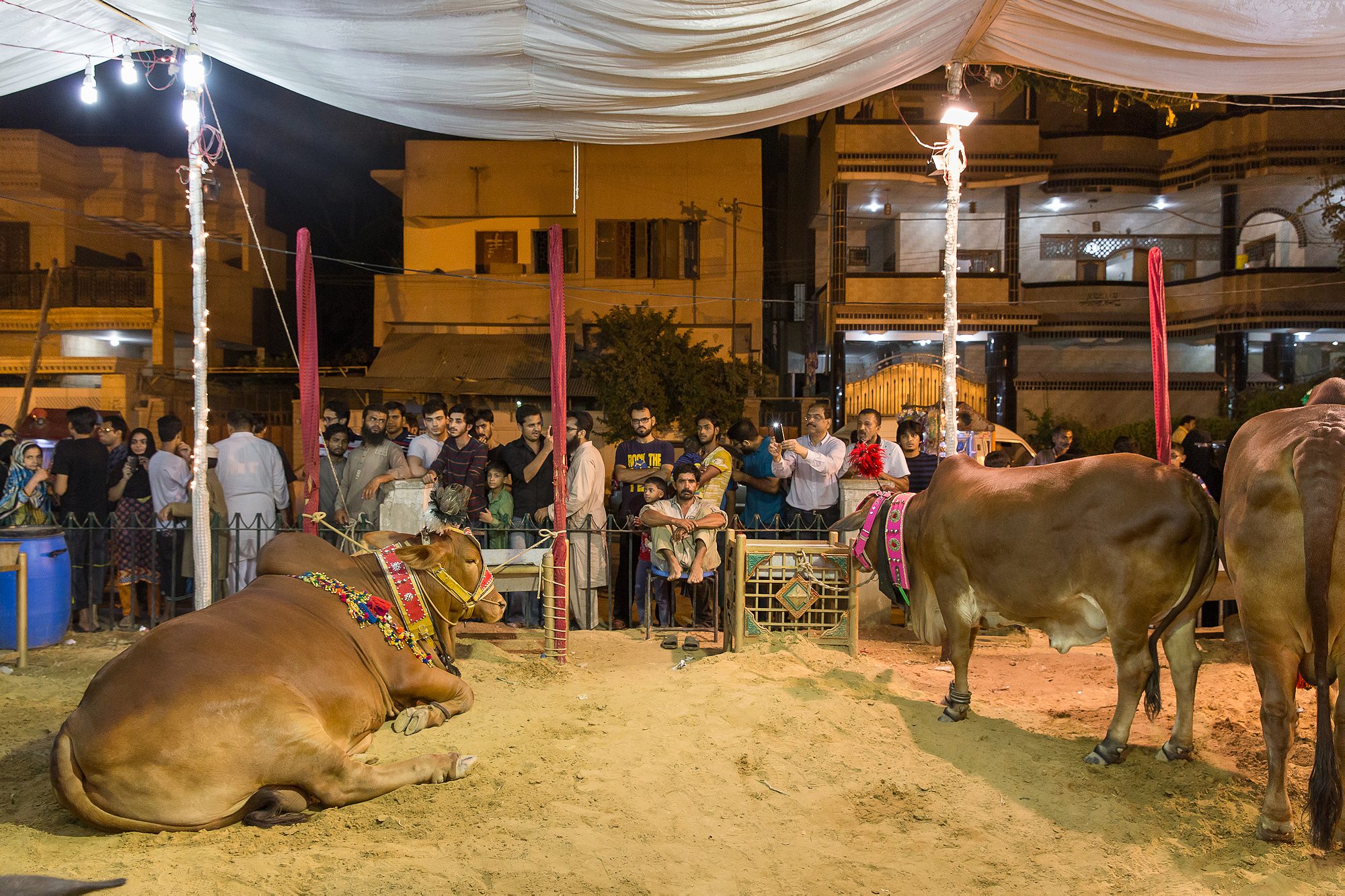
The bulls are massive, seven-feet-tall, nearly 3,000-pound beasts that undertook a twenty-two-hour journey from Sibi in the Balochistan province of western Pakistan to the cattle market in Karachi’s upscale Defence neighborhood. As one of the bulls sits placidly on the ground, another tears at its rope, violently exhaling a humid spray over the crush of people jostling to for a better look at the animal. A man leans over the pen to take photos on his cell phone.
Janoo sits on a nearby bench while Shah Mohammad, the bulls’ caretaker, stands in the pen with one of the bulls. “This is an award-winning bull. It’s won an award in a cattle show in Quetta,” Janoo says. “There’s usually a lot of financiers’ money involved in this.”
Before Eid, Karachi sees dozens of men like Janoo circle animal pens. They work behind the scenes far before the new moon for Dhu al-Hijjah—the Islamic month during which Eid falls—appears. Eid brings out the rich and the poor, all looking to profit and earn kudos and blessings from the slaughter. On a Saturday afternoon in the market, while Janoo holds court, Mohammad, an affable, unassuming young man in a brown tunic and trousers, hand feeds the Sibi bull a watery, gloopy feed. The bull will consume eleven pounds of buffalo milk and almost 18 pounds of millet through the day. For the last four years, Mohammad has raised the bull for slaughter, one of the thousands that will be sacrificed around the world, but they won’t all have such a hefty price tag.
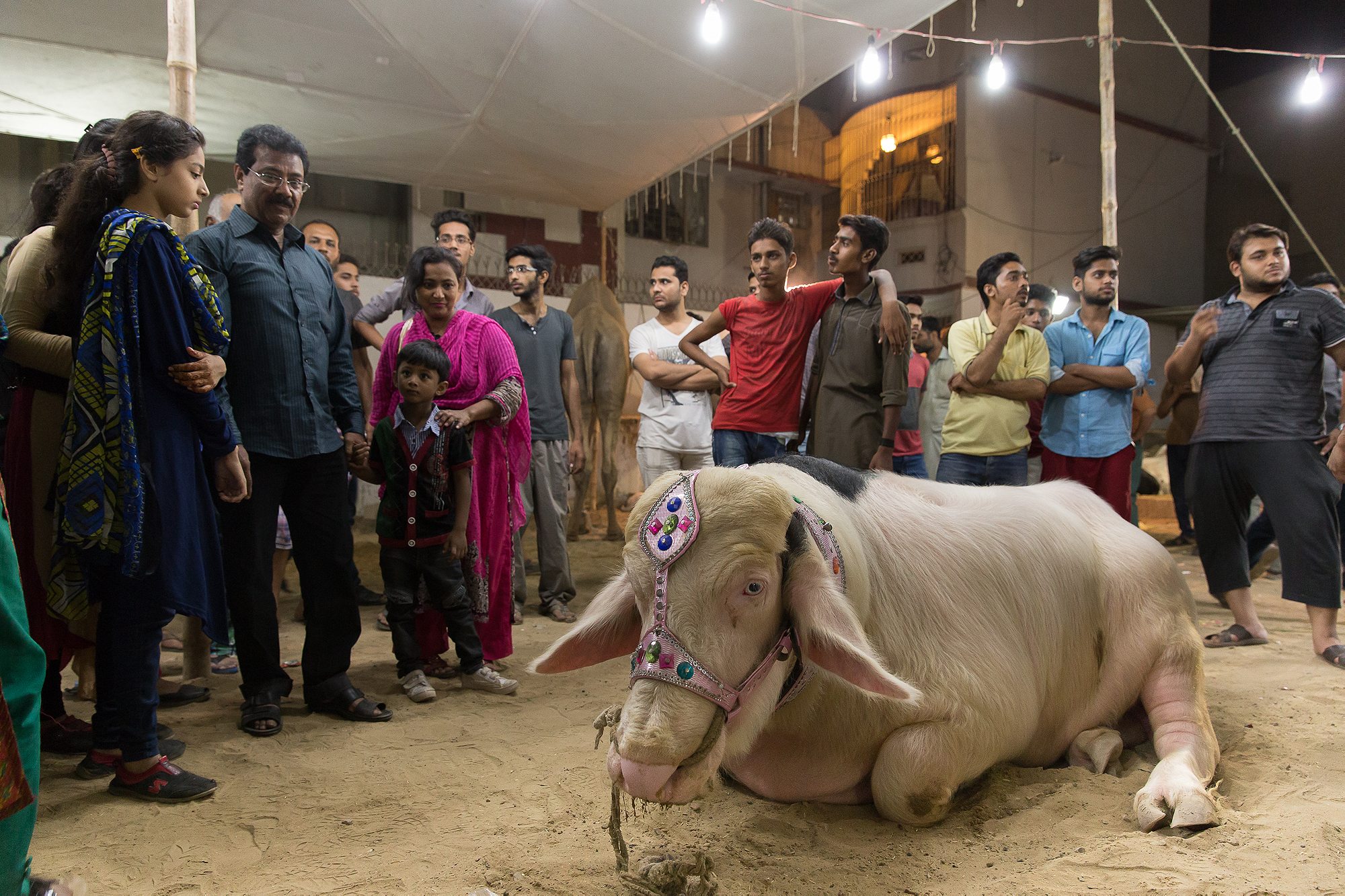
The bulls remain under tents for days on end, as people venture to the market to gawk, inquire about prices, and bargain extensively. After the buyer makes the deal, he contracts a trailer or a pickup van to transport the animals home, though others just stuff them into rickshaws or cars. The animals are housed in empty plots of land nearby, or in driveways, or tied up just outside the house gate with a pile of feed nearby.
I trudge through piles of manure to arrive at the Holy Grail of cattle: the much obsessed-over tented VIP block. With billowing canopies and huge billboards emblazoned with the names of cattle farms—including one featuring a photo of the head of the Pakistani army—this block and the animals housed within are the stuff of great conjecture and gossip. The tents remain closed during the day and only open after sunset, when the cattle appear gleaming under lights powered by a generator.
No one is around during the day to open the tent, but a couple of curious bystanders peek through a rip in the blue-and-white striped canopy of Amir Dilpasand, whose owner named the venture after his family’s other business, a snacks and sweets mart. A group of dozy bulls lounge on the ground under their own designated mini-canopies. These disinterested animals represent months of breeding, a strong genetic lineage, and the finest meat.
The top breeders here have an aura of exclusivity. This tent is the zenith of the cattle market with price tags to match. “Dilpasand had an animal that sold for 48 lakh ($46,500). They have another for 52 lakh ($49,350),” says Imtiaz Ahmed, a cattle breeder who brought five bulls from Sahiwal to sell in Karachi, relating market gossip. The highest advertised priced animal was reportedly half that amount.
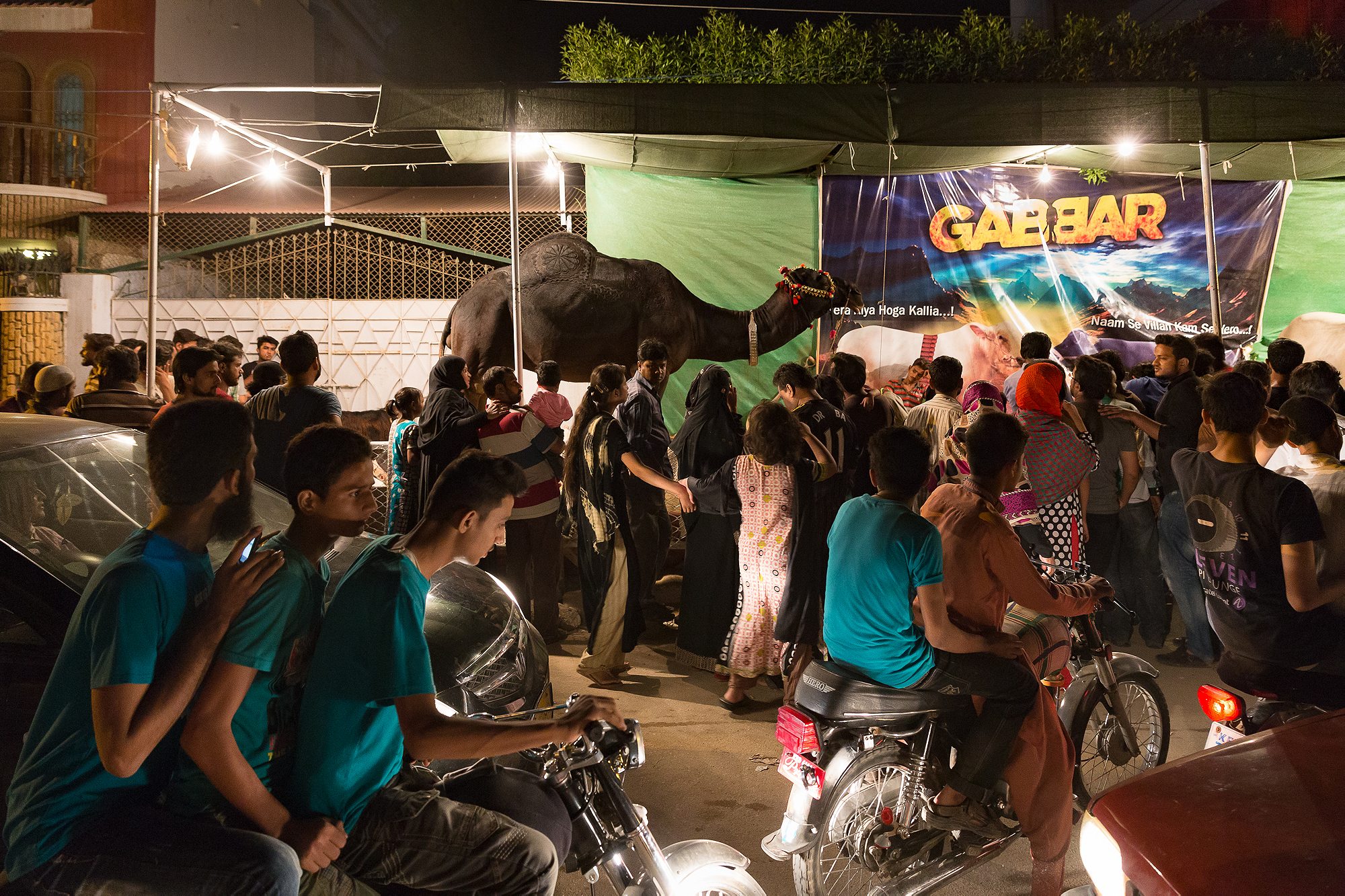
Eid in Karachi was once a simpler affair. But over the past decade, Karachi’s nouveau riche have turned cattle buying into an extreme sport, inspired by men like Aqeel Kareem Dhedhi. The business tycoon is a major player in the Karachi stock market and often courts controversy. Dhedhi declined to put a figure on his wealth when speaking to one of Pakistan’s savviest TV interviewers, but his heavyset figure, swathed in a white starched cotton tunic and trousers, is a common fixture on television. Karachiites gawk at the man when he appears in public. His daughters’ wedding ceremonies occupied gossip hounds for days, and he’s considered to be one of the most prominent figures of the ethnic Memon business community.
But Dhedhi is most well known in Karachi for kick-starting the trend of ostentatious displays of cattle, by putting up a grandiose cattle tent outside his residence, featuring imported animals being kept in relative comfort. As tales of the animals housed within the tent spread, people flocked to it to witness the spectacle.
This year, Dhedhi seems to have scaled back the excesses, buying goats just a few days before Eid. But now everyone wants to buy expensive animals and house them in a tent to make a statement, though some may have even exceeded that brief. One trader claims that one of the largest cattle markets this year has been set up by a politician’s son. “There’s no security for traders, and the cows have commandoes,” he sniffed.

This year’s big trend among the new-moneyed set is buying yaks—forced to suffer in Karachi’s humid clime—which prompted Islamic scholars to ponder whether yaks could even be sacrificed. Scholar Mufti Muneeb-ur-Rehman, who also heads up the country’s moon-sighting committee, told The News in 2010 that only domesticated animals could go on the butcher’s block. “Some animals are Halal to eat but their sacrifice on Eid is prohibited. For instance, a deer’s meat is allowed for consumption, but its sacrifice is not permissible,” Rehman told the newspaper. “Since the inhabitants of areas where yaks are reared considered them to be different species than cows, there is a doubt. To avoid any doubt, it is better that yaks are not sacrificed.”
But with or without yaks, cattle need to be bigger, better and have been bought from a VIP farm to impress.
According to Mutahir Kamal, who tracks cattle sales, the most expensive animal this year was a $23,700 bull sold by the Aamir Dilpasand cattle farm. The offspring of that bull sold for $14,000. Photographer Burhan Qureshi’s most popular photo this Eid—”Have you seen it? It was a huge hit”—was of a black bull that cost around $22,000. He believes the animal is being raised for slaughter next year.
“It looked like a jinn ka bacha,”—a jinn’s child, an expression used to signify something otherworldly and huge.

The ostentation is unique to Karachi, says Omar Shahid Hamid, a police officer who specializes in counter-terrorism and criminal networks in the city. While elsewhere in the country, city-dwellers go to their ancestral villages and small towns and organize slaughters there, in Karachi—a city of migrants—people stay put and put on the glitzy cattle shows. “In Karachi it’s a see-and-be-seen kind of game,” Hamid says.
Pakistan’s largest city is equally known for crime as for cosmopolitanism, and the Eid holiday is just as rife with threats and wrongdoing as any other day of the week. In a place where anything from a goat to an iPhone can be stolen at gunpoint, so too can the skins of the sacrificed animals. Even before the animal has been portioned up, Karachi’s criminal elements look for their way to step in. Strongmen of extremist religious groups and religious charities (fake and real), political party workers, and small-time criminals: they all look to profit from the sale of the animals’ hides.
This introduction of criminality into religious rituals can cause confusion. One reader posted a plaintive request on the Darul Ifta Jamia Binoria seminary’s website, asking for a scholar’s advice on what to do when a hide of an animal was “taken away.” “Mufti sahib I wanted to know about sacrificial animal hides. In our neighborhood, the hides are taken away from people without their consent… At some places this has happened that if they have refused to give over the hides, [the ‘collectors’] have shot the animal while it was alive. If this wounded animal is in misery and is sacrificed, would it be permissible to consume it?”
Yes, the seminary wrote back, one should give the hide if one’s life is at risk, and also donate an amount equal to its price. “If an animal is shot and then sacrificed, eating its meat is halal and if this happens during the days of the sacrifice then the sacrifice will be considered to be lawful,” the fatwa text stated.
The hides racket is a dangerous one, given the mix of extremist and militant groups involved
For more than two decades, criminals and religious and political strongmen have gone door-to-door snatching hides—“snatching” being the word of choice for any kind of theft in Karachi. This means they force people sacrificing animals to donate leftover hides to them, often at gunpoint. “It has become a very lucrative practice,” Hamid says. “Earlier, people would just give hides to their local mosque, who would then sell a few. But when it started on the ‘Karachi level’”—citywide and amplified because of the extent of crime and the fight for resources—“with political parties involved, it became serious money.”
The hides racket is a dangerous one, given the mix of extremist and militant groups involved. But this isn’t a small-time operation. Anwar Kazmi, a veteran officer of the Edhi Foundation nonprofit, speculates that the business of hides may be worth billions of rupees.
But why hides? “It is money you can’t audit,” he says.
In 2011, the Supreme Court mentioned the fight for hides in its judgment on the state of lawlessness in the city. This year a government-sponsored PSA aired at a local cinema, encouraging people not to donate to unknown groups, lest their donations end up funding terrorism.
“It’s black and launderable money in that sense,” says Hamid.

As Eid nears, charity groups plaster Karachi with banners and billboards, advertising shares in collective slaughters and asking for donations of hides. They pull out all the stops: The charity wing of the Jamaat-e-Islami—one of Pakistan’s main religious-political parties—asks for hides through a billboard featuring the image of Aylan Kurdi, the Syrian toddler whose body washed ashore in Turkey. The Falah-i-Insaniat Foundation—a self-described charity that is accused of being a wing of the banned Lashkar-e-Taiba militant group—advertises donations for its work in Afghanistan, Syria, Palestine, Pakistan, Burma, Somalia, and the disputed territory of Kashmir.
Collecting sacrificial hides, much like everything else in Karachi, has become part of a turf war between criminals and strongmen of political and religious parties. Every group does it, including small-time operators, to show themselves as players in the game. “There are bragging rights—x number of hides were collected by a group,” Hamid says, just as there’s internal corruption within some parties. “If one guy collects a thousand hides, he’ll sell 900 to his group and keep a hundred to sell himself.”
And some criminals just bypass having to do the dirty work. When the criminal syndicates in the Lyari district—an area known for producing the country’s best footballers as well as biggest gangs—were at the height of their power, they would just steal other groups’ hides. “You’d often hear this stuff over the wireless,” Hamid recalls. “They’d hijack one group’s van, and you’d hear, ‘The van is heading towards Lyari.’”
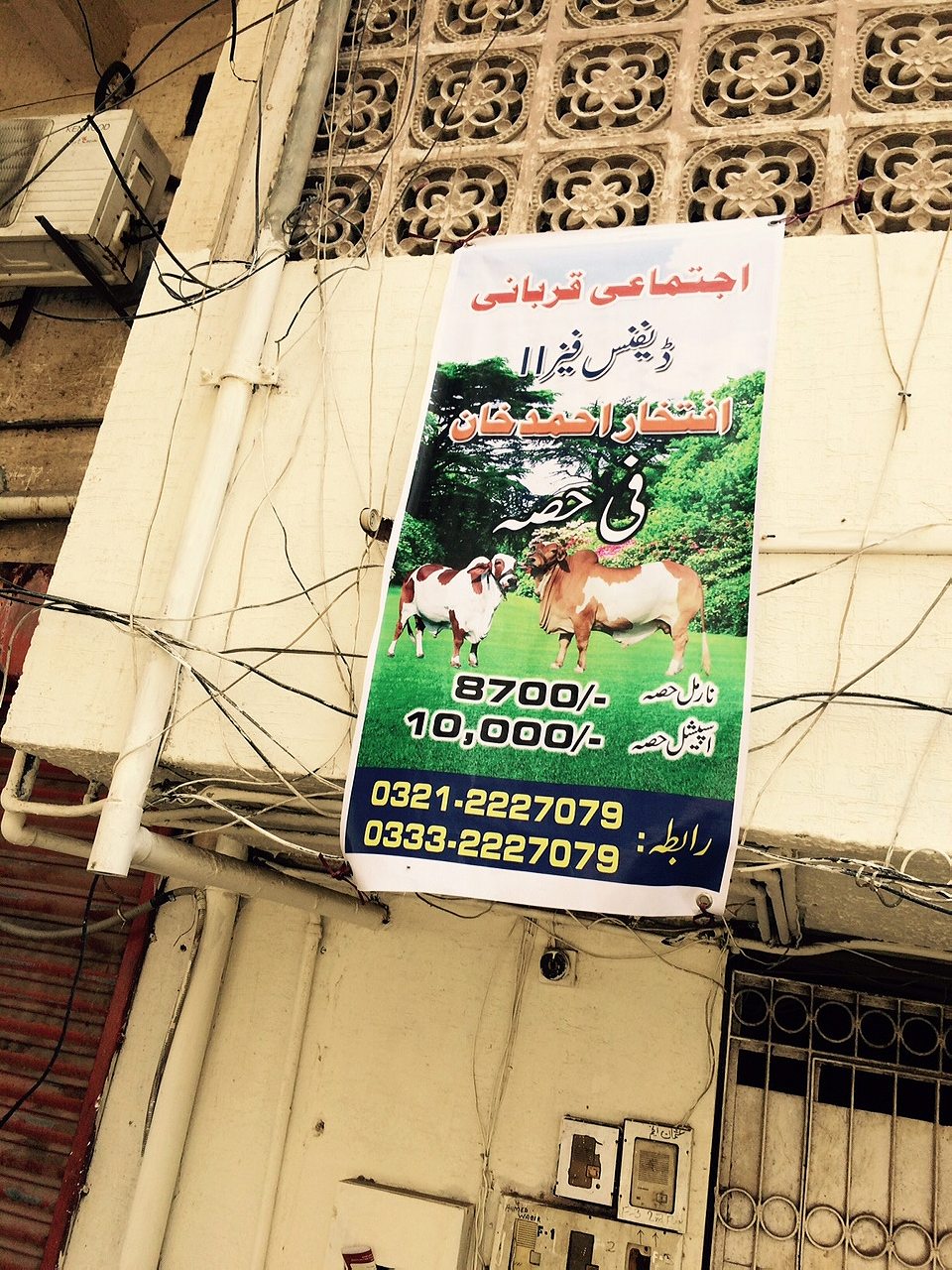
The journey of an animal from the VIP tent to its stolen hide ending up in Lyari is months and years in the making, as cattle farms raise their finest animals or import cows from Australia. But word of mouth, reputation, and rumor aren’t enough to move cattle. Traveling to markets and farms is inconvenient, and many farms aren’t even accessible to regular visitors. But if Mohammad won’t go to the cattle, the cattle will come to Facebook.
Burhan Qureshi helps provide a window into the exclusive world of cattle farming. Qureshi is a 22-year-old Karachi-based photographer who is commissioned by cattle farms and animal owners to shoot animals—from the time they’re being advertised for sale to when they’re being sliced open. “I just did a shoot with goats while they were getting a shower,” Qureshi says, when reached a few days before Eid. “And I’m booked on the second and third day of Eid; I have to shoot slaughters.”
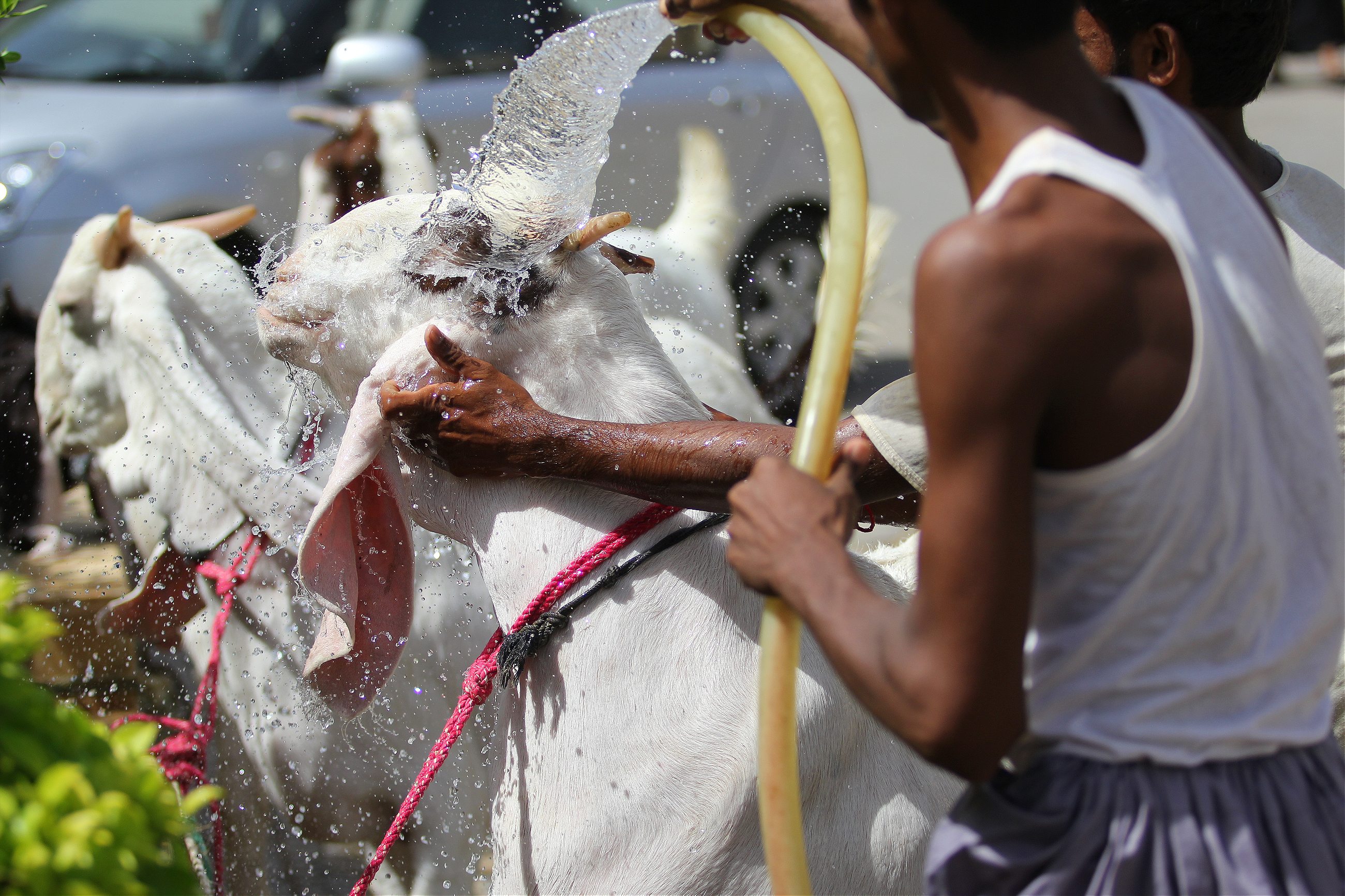
The people who commission Qureshi—and those who admire his photos online—aren’t just wealthy breeders and customers. There is a strangely cattle-obsessed side of the Pakistani internet, an entirely testosterone-fuelled mini-industry of cattle photos, likes, and odes to cattle. Almost every photo of a bull posted online has a half-dozen likes, and comments like “mashaallah” (“God has willed it,” offered as praise) and “awesome click.”
This year’s big trend is selfies: owners taking selfies with their purchases, selfies at the cattle market, and selfies before-and-after the slaughter. “Selfies were almost nowhere last year. This trend is at an extreme, even inside the tents,” Qureshi says.

Qureshi is a self-taught photographer who started off with digital cameras and moved onto DSLRs. “Cattle farmers want two things: one, the colors, and the other, that the animal looks huge,” he says. A cattle shoot can pay up to $300—usually daylong, on-site affairs that involve photographing 30 to 35 animals. “The most difficult to shoot are black or white animals,” he says. Farm owners usually want still shots so potential customers can see the animal’s hump, girth, back, and legs.
The trick to getting animals to stand still and pose, apparently, is first to let them loose first so they tire themselves out running. “And then we tell the guy with it how to move it in a certain direction. Sometimes it can take fifteen or twenty minutes just to take one photo.”
A charging bull is difficult to deal with at the best of times. Not so for Qureshi, who says he enjoys cattle shoots just as much as he enjoys weddings, though the latter is more time intensive.
And cattle photography isn’t without its risks—three years ago, Qureshi was mugged at the Sohrab Goth market and lost his camera, and he hasn’t taken photos there since. “At least I didn’t lose the lens,” he says. It’s a consoling thought.
Men like Qureshi aren’t just doing this for the money. They have become self-anointed guides of the cattle market. Qureshi and a friend of his set up a Facebook fan page for the Sohrab Goth market in 2010. “We had a lot of photos, and my friend really loved animals,” he says. “And at that time there was a new trend Facebook had of pages so we set one up.”
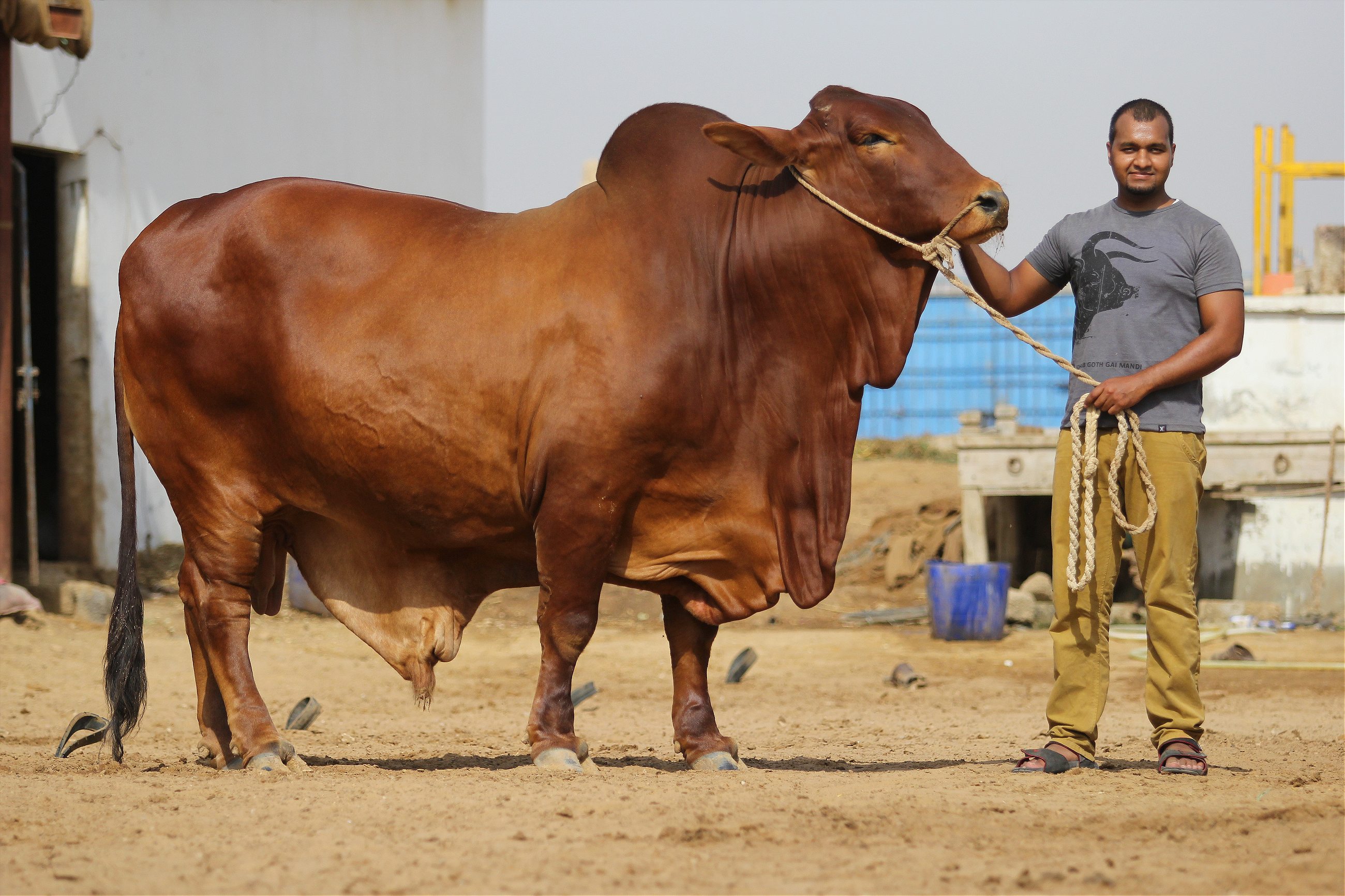
It’s a strange kind of obsession, and one that has gripped a 16-year-old college student. Mutahir Kamal is one of the administrators of the Sohrab Goth Maweshi Mandi Facebook page. He has slept, breathed, and posed with cattle for years, and this year, he turned his life upside down for Eid. His page, with 34,782 likes—still pales to the more popular Sohrab Goth Gai Mandi page that has over a whopping 200,000 followers—but Kamal takes his self-created volunteer job very, very seriously.
Kamal maintains the page year round, but he kicks into high gear before Eid, basing himself out of the main cattle market and whiling his time with breeders. He pulls 12-hour shifts to update the Facebook page and he has an uncanny ability to rattle off facts: How many animals were offloaded from trucks this year; how many were brought in the year before; which farm has the most imported cattle. His round-the-clock updates include news on the market’s parking lot, the status of animals in the market and photos sent in by buyers. There are enough cattle to last several lifetimes, but Kamal thrives on this. On September 20, he told his followers that he’d been up and at it for 72 hours.
“I just want to do what I like,” he says. “I’ll worry later about falling ill.”
Kamal seems intent on making the most of this time, even though there’s a heat wave one weekend. He tries to skip college during pre-Eid season so he can spend his days and nights in the market. That doesn’t always go down well with his family. “I do get yelled at,” he says. But he tries to go back to his house, eat a meal and sleep for a few hours in the evening before he heads out to the market again. He’ll soon be occupied by his own animals—even though he isn’t a big fan of imported animals, he’s bought two Australian cows as well as a locally bred one for this year’s slaughter.
Kamal is indignant over the way some people treat their cattle—not housing or slaughtering it properly—but mostly, over how they compete to buy animals. “There’s this really bad habit people now have of asking for animals that are larger to the ones their neighbors have—‘This is what my neighbor bought, I want something bigger than that.’ This is very wrong,” he says. “People shouldn’t compete like this.”
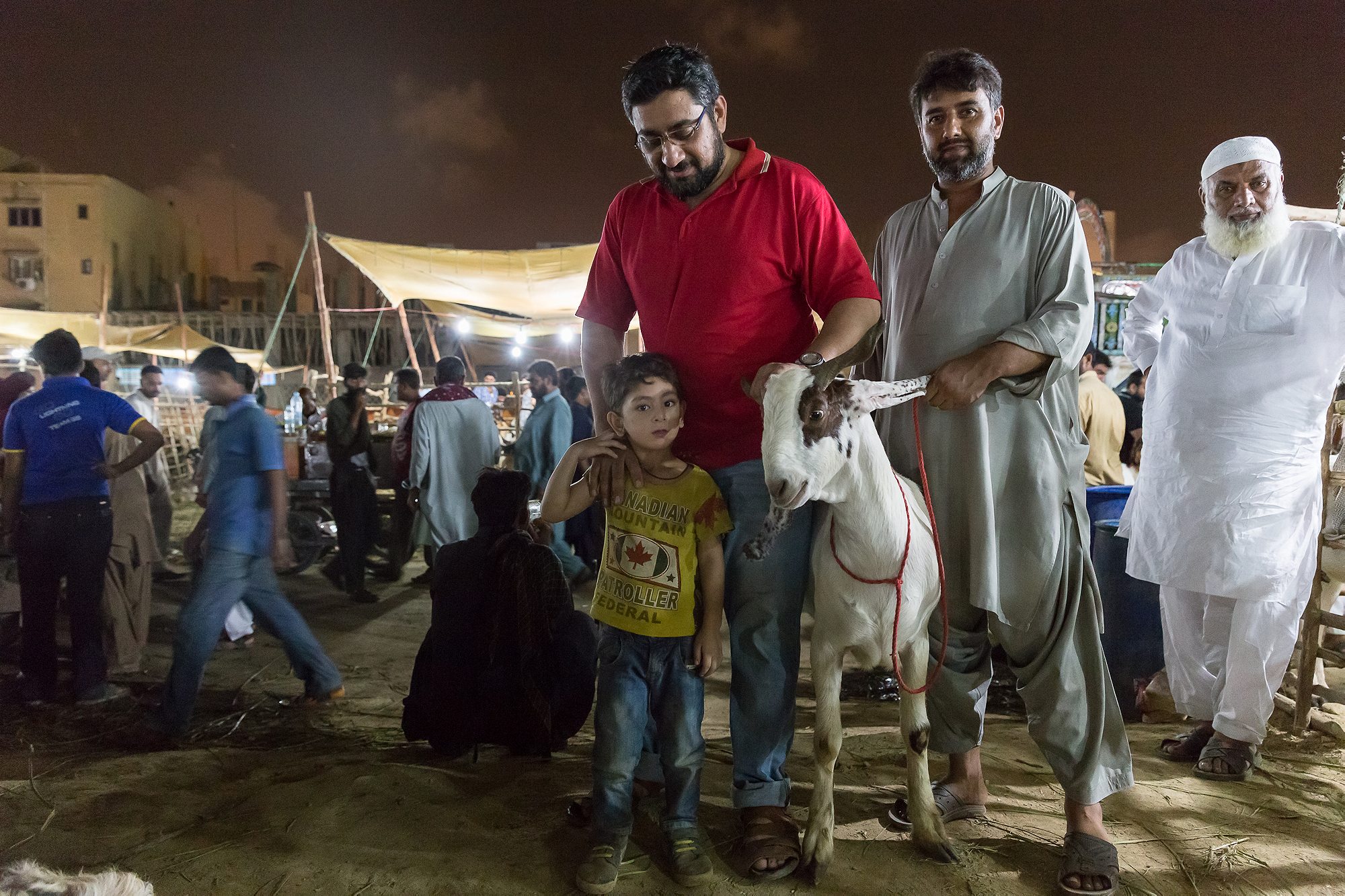
Kamal is competitive, too—on Facebook. While his Facebook page was set up by his friends in 2007, he only came on board two years ago. He claims to be the only one working on the page nonstop and elicits praise online once Eid ends. After Eid, he posts online that he has finally succumbed and fallen ill. A day after the Eid holiday, he flies off to Islamabad.
Part of his gig is connecting prospective buyers to the cattle farms. His approach is democratic: He’ll try to help out everyone, regardless of their budget. Kamal says he gets up to a hundred messages via Facebook every day, from people looking for cattle to buy to asking for advice on which section of the market they should venture to first. “I just want everyone to get the best animal,” he says.
Surely he could make a quick buck getting commission on the sales. But this isn’t for monetary gain, unlike, he says, other Facebook pages that make money through adverts.
The Sohrab Goth Gai Mandi page—run by Qureshi, the photographer, and his friends—does feature paid content, signifying how big the circus of cattle gets every year. It now has its own PR circuit. Given their Facebook page’s 200,000+ likes, Qureshi and his fellow page administrators are invited by high-flying buyers for a meet-and-greet with their cattle. This year, they were invited by a Pakistani cricketer who wanted them to visit and photograph his animals, and they might have an invitation from an actor as well. Qureshi says everyone does this to stay in the limelight, and show off to the world—and their fans—what sacrificial animals they’ve purchased this year.
While yaks have gone the way of controversy, camels are a safe bet for Karachi’s cattle shoppers looking to impress their neighbors. “Everyone sacrifices a cow or a goat,” Ahmed says. “A camel—only one out of ten people do that. It’s a Sunnah [a tradition of the Prophet Muhammad] and people like sacrificing camels. It is one of a kind.”
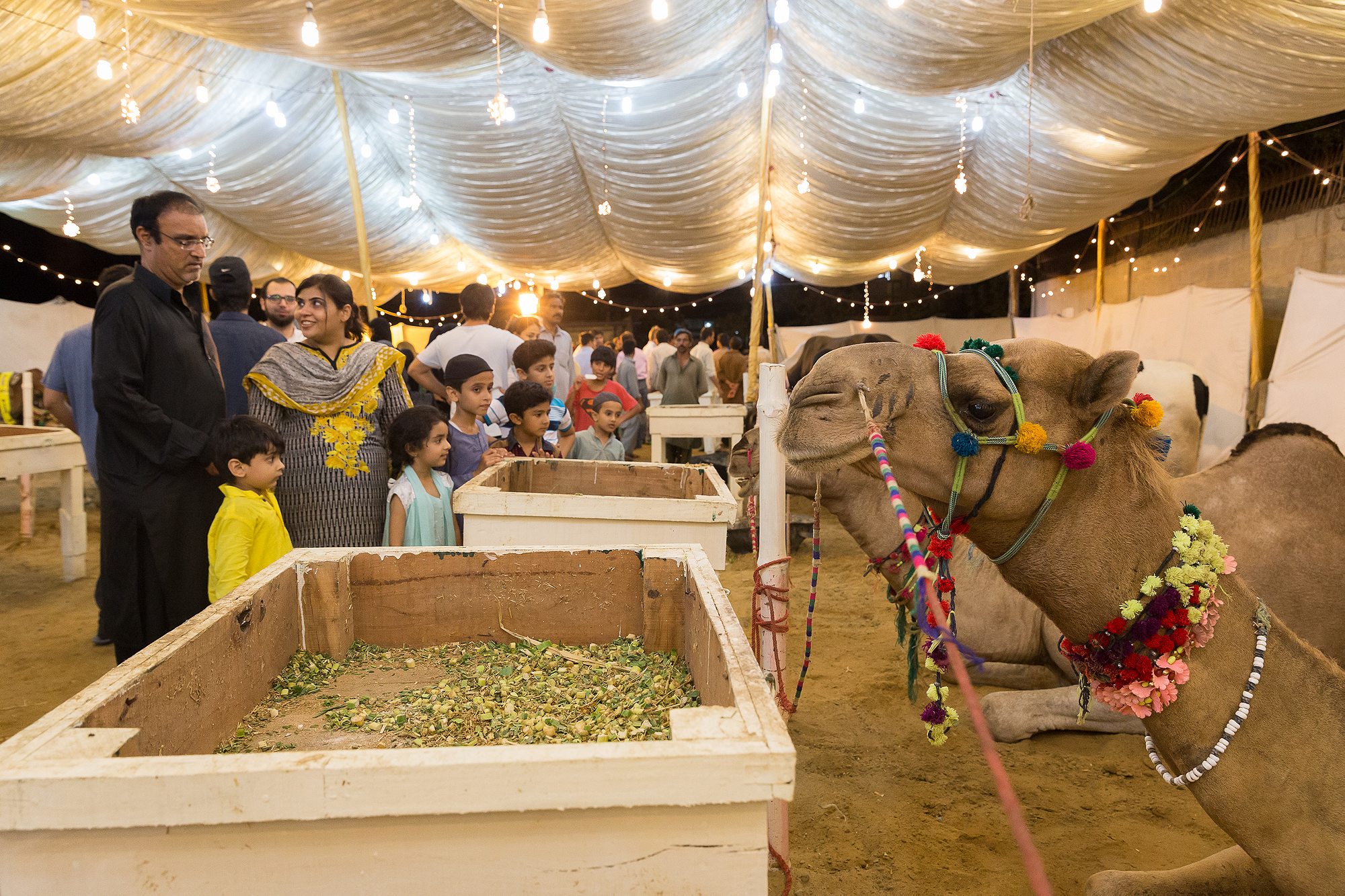
White camels are a big deal, Kamal says they may have perhaps become too mainstream. “The white camel is beautiful, and it looks different, but the people of Karachi have just cleaned them out of the market,” he says. “The smallest one is being sold for 250,000 rupees,” or about $2,370.
Over the Eid holiday, Qureshi has been asked to shoot a camel slaughter at someone’s house. “It’s going to be a series of continuous shots,” he says. His clients “want it as a memento of sorts—it’s a memory, that they had these camels.”
Shooting through guts and gore doesn’t faze him. “I’m used to the slaughter now. The thing is, I’ll do anything for a great photograph.”

If some people show off their wealth by buying pricey animals, others are hoping to strike it rich. Wali Ahad, a lanky 21-year-old from Karachi who drives a rickshaw for a living, is one of them. Weeks before Eid, he sets up shop at the Defence cattle market. Ahad’s family has sold cattle for years out of their house in the low-income neighborhood of Chanesar Goth, and generations of his family bred cattle in the outlying Sindh province. Every morning, Ahad feeds the cattle before leaving for work. The women in the house give the cattle water during the day, and when Ahad returns in the evening he feeds them again.
The family usually sells cattle to their neighbors—sometimes at throwaway prices, he says—but this year, Ahad is taking the family trade out of their comfort zone and into the cattle market in Defence, hopeful of striking a better bargain. He pays $320 in rent—having split the space and the $640 rental fee with another guy—and has to contend with the competition. Last year, around four thousand cows and 15,000 goats were traded at the market. Competition is tough, and it’s an expensive proposition: Cattle sellers are charged for the space depending on the number of animals they’ve brought, as well as for electricity and other incidentals.
On a weekend afternoon before Eid, Ahad admires the five bulls he has brought along. Their horns and faces are adorned; one has a large silver pendant resting between its horns, another is wearing a headpiece of sorts made from brightly colored thread. “This one was my brother’s,” he says, pointing to a bull sitting complacently on the ground. “My brother is dead now, so my heart didn’t really accept selling it, because it’s what he had left, it’s a symbol of him,” Ahad says. “He just died this month. He was in a market, and there was a lot of gunfire there, and he got shot too.”
One of the five bulls was raised by Ahad’s niece, who didn’t want to see it being carted off for slaughter, either. Despite her remonstrations, Ahad brings it along anyway.

But his brother’s pet was another matter altogether. “He did want to sell the animal, but next year when it was healthier,” Ahad says. “I told him ‘As you wish. It’s your thing.’ How was he supposed to know that he was going to pass away? This is the kind of thing that makes me cry. But we can’t have the animal just standing around for the rest of its life. We have to sell it,” he says, with an air of finality.
Ahad sees the cattle sales as a way to something better and better. This is his first foray into the cattle market and he hopes that raising cows can be more than just a pet project, and he could eventually replace his day job. “The rickshaw is just a job. This is my passion. I had other things I liked to do, like cricket, etcetera, but I’ve left those now. With this, the thing is you get to save a little money this way and make a bit of a profit. I’ve been around in the market and the rates are much higher than ours, but I just want to get a fair price for the animals. I only have hope to go on.”
On most days, these pipe dreams seem impossible in Karachi; a city that seethes with hostility at the best of times. But during Eid, it is easy to see fortunes being made and spent. There are many Wali Ahads, all staking their claim on the market, all hoping they can move up in the cattle leagues and in life.
A few nights before Eid, I go back to his spot at the market. The Sibi bulls have gone—a couple of people say they sold above asking price—and so are Wali Ahad and his bulls. Instead, there is another man, also a rickshaw driver, also selling five bulls.

Even though Karachi reeks in the days before, during, and after Eid, there is an evident air of camaraderie and joy. The cattle markets are a world unto themselves, a brightly-lit mini-carnival. At the Defence cattle market, voyeurs abound—children who bike to them from nearby neighborhoods to see the animals, and young teenage boys laughing at a group of men who have broken out into a mini-scuffle in the parking lot. There’s a sandy ridge of sorts between the parking lot and the market, and about two dozen men are rubbernecking to see the fight. “This is the only amusement at this time of the year,” says Bilal Khan, 19, as he hangs out with a friend one evening. “We see cattle try to escape; this is the kind of stuff one can enjoy here.”
Bilal and his friend watch a runaway bull that its handler is trying to force into a truck. “This bull has gone insane,” his friend tells him.
“Look, he’s running!” a kid standing nearby shouts, but no one makes way. Everyone is busy staring. The animal is corralled and sent off.
For the few hours or days in their new homes, the cattle are fed, pampered and posed with. Across the city, kids walk around their neighborhoods leading their animals by the hand, parading them around to show them off. The air is rent by the sound of moos, baas, and jangling bells. There are impromptu cattle races. In my neighborhood, boys egg their bulls on to victory in the cattle race with cheers, whoops, getting guys on motorcycles to honk at them from behind and scare the cattle into running. It is frustrating for some—one Eid, a guy yelled at his bull, his voice echoing down the street: “Son of a bitch, RUN!”
The joyous mood dissipates as Eid begins and the hour for slaughter approaches. The photos and status updates on the Facebook fan pages begin to reflect a grimmer mood. Children beg their parents not to slaughter their pets. Cry-face emojis from people sad to see their animals about to be butchered populate the comments section of Facebook pages. Despite the sums of money involved and the fact that the animals are essentially raised for slaughter, tending to the sacrificial cows and goats is a deeply personal endeavor. Every breeder confesses to feeling sad at seeing cattle go off to slaughter, including Shah Mohammad, as he feeds the Sibi bull. “Of course it is sad when the animals get sold,” Ahad says sharply, as if my suggestion that it could be anything but sad is outrageous. “It makes you cry.”
Organizing a slaughter is a difficult task. Anyone can slaughter an animal, Kamal says, but a proper butcher has to skin the animal and divide up the meat properly. And on Eid, butchers are highly sought after mini-celebrities.
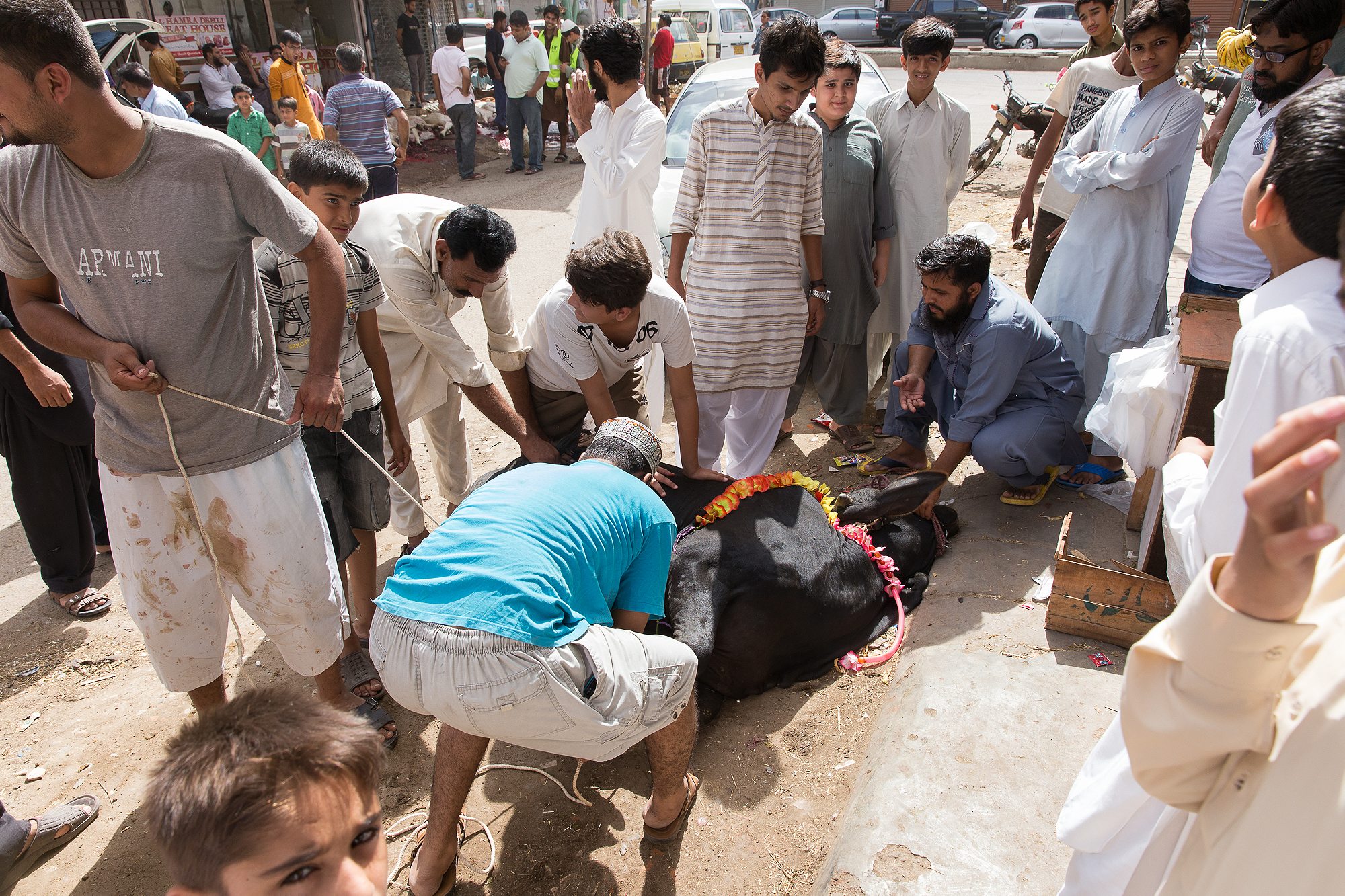
At 7:30 a.m. on Eid morning, Iftikhar Ahmed Khan waits for his team of butchers to show up. The property dealer has organized a collective sacrifice in an empty plot of land featuring 48 animals, with shares costing $82 to $95 each. His goal is to finish off the sacrifice by the early evening, courtesy a group of 35 butchers and their assistants. Some of them are late, and Khan keeps redialing their number, asking them—politely—to show up at the site. A water tanker is at the ready to clean the area post-slaughter. Throughout the Eid holiday, non-profits pick up the hides from people’s houses. The city’s sanitation workers are left to clean the remains, the piles of offal stacked up on every corner and lying in the streets.
A van arrives full of men carrying butcher blocks and jute bags to collect the remains. A pole is designated to hang up the precious hides. By the end of the Eid holiday, the paramilitary Rangers force—which has become hugely influential in Karachi in recent months—claims to have gotten hold of over 18,000 illegally seized hides. The Edhi Foundation’s Anwar Kazmi says collection at the non-profit went up by 50 percent this year because the Rangers have been enforcing a code of conduct. Some of the illegally seized hides were handed over to the foundation as well. But Kazmi says that at the end of the day, the bulk of the hides doesn’t go to non-profits, but to religious groups and mosques.
Across the city—and outside Khan’s tent—people with shares in the animals gather to witness the slaughter. Some drive up while others stop by after offering Eid prayers at the mosque, still in their starched Eid clothes. The butchers have organized themselves. A group of men watches the proceedings from an under-construction building across the street. A butcher drags a white bull to one side and ties its front hooves together. Two men force the animal to lie down while another bull looks on unworriedly, perhaps not realizing it is next in line. The men hold the bull down firmly as the butcher says “Allah, Allah” and slices a knife across its throat. Bright red blood gushes out and pools onto the street.
The cow thrashes once, twice, and then lies still.
